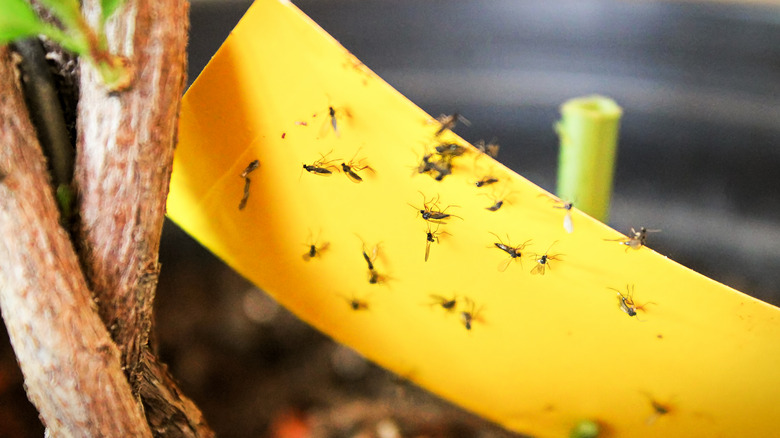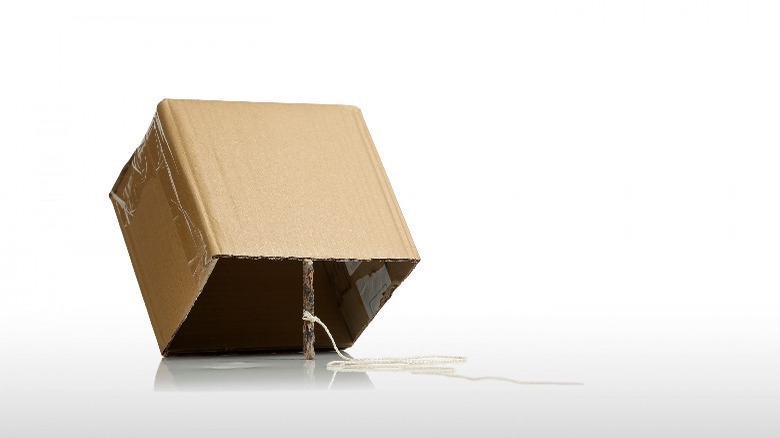How To Get Rid Of Stink Bugs In Your Home
Many people are familiar with the hard-shelled, flying, indoor, and odiferous pest known as the brown marmorated stink bug, most commonly referred to as just the stink bug. The brown insect wasn't always a problem, with PestWorld noting they first came to the United States (Pennsylvania, specifically) in 1996.
Stink bugs are native to Asia and get their name from the unpleasant odor they release when killed, which Suburban Exterminating describes as resembling the scent of a burnt tire, with pungent oily, woody, and even cilantro-scented notes. Stink bugs have glands in their thorax that produce the stench when threatened or killed, but the pungent nature comes from their unique ability to get the scent on their exoskeleton, which then quickly disperses into the air (via NC State University News).
Stink bugs are found at higher rates indoors during the late summer and early fall, as they search for a warm home in preparation for the upcoming cold winter months. They can be found indoors year-round, though. If you have a troublesome influx of stink bugs, it isn't as simple as killing them or letting them outside. Luckily, there are a variety of ways to get rid of your stink bug infestation.
1. Soap and water
If you find any type of bug in your house, your first instinct may be to bring it outside. This isn't necessarily the most productive route for getting rid of stink bugs, though, as they'll just come back inside. As such, the most productive methods for getting rid of the hard-shelled pest will be lethal.
This first method comes from HGTV and involves water, soap, a jar, and, optionally, vinegar. In a jar with a wide mouth, add the water, soap, and a splash of vinegar. Then, locate a stink bug. As HGTV points out, stink bugs will drop down from their current spot if they feel threatened. Exploit this instinct by putting the soapy jar of water under them, and they'll fall into the cup and eventually drown. This method isn't great for an influx of stink bugs but works well for the occasional bug sighting.
2. Vacuum
Stink bugs can't just be squashed like other common household pests due to their pungent and lingering defensive odor. This makes even the occasional stink bug a major nuisance, let alone an infestation. A quick way to get rid of stink bugs is by using a vacuum to suck them up, according to Bob Vila. Note that this method is not suitable for a bagless vacuum, as the dead bug scent will proliferate the entire machine.
Make sure your vacuum bag is empty before vacuuming. Consider using the hose attachment as opposed to the whole vacuum, which could crush the bugs in the process and render this whole method pointless. Once the bugs are safely in the bag, immediately tie it up securely and throw it away somewhere decently far away from your house. Leaving the bag of dead stink bugs may attract more bugs to investigate the scent.
3. Chemical pesticides
Another method for eliminating your stink bug infestation is by using chemical pesticides. Before spending all your money trying to find a pesticide that works, keep in mind that this may not be the most viable method. As the National Pesticide Information Center points out, pesticides are mostly ineffective at permanently removing stink bugs.
That doesn't mean it isn't worth a shot, though. The Environmental Protection Agency recommends aerosol and fogger sprays, but notes that stink bugs can still emerge from cracks in walls, doors, and windows after the pesticide has dried up. There are plenty of insecticides specifically marketed as lethal to stink bugs, but Country Living says to look for products containing deltamethrin.
According to The Morning Call, this chemical attacks the stink bug's central nervous system. Some products are also specially formulated to leave behind the chemical long after the water has dried, which makes it effective for longer. Be careful with this method if you have children or pets.
4. Essential oils
For a more natural, organic approach to getting rid of your stink bug population, HGTV recommends various natural oils. This method not only gets rid of your stink bug problem but leaves behind a pleasant and refreshing scent in its wake. It involves a spray bottle, water, and a mint-based (peppermint, spearmint, etc.) essential oil.
Simply combine 10 drops of the oil with 16 ounces of water and spray both directly near (not at, as they may release their scent if scared) the bugs, as well as around entry points to your home. According to Today, stink bugs don't like the smell of mint and will avoid areas where the scent is present. This is why it's crucial to apply it to access points of your home so they don't come back inside.
Another natural oil you can use to combat stink bugs is neem oil, which is often used as a natural pesticide when applied to both indoor and outdoor plants. Unfortunately, this oil has a slightly offensive garlic and nutty smell. It won't kill the stink bugs immediately, but it will eventually completely eliminate your stink bug population. Dilute it with water and spray around entry points and near stink bugs.
5. Detergent spray
This method is similar to the earlier mentioned soap and water method but doesn't require you to get up close and personal with your resident stink bugs. Bob Vila recommends crafting a homemade spray to repel and kill any stink bugs you may encounter. For this method, you will need liquid laundry detergent, water, and a spray bottle, as well as any potential additives like mint oil, garlic oil, vinegar, etc.
Simply combine the water and detergent in a 1:1 ratio and add it to your spray bottle. If you want to add other stink bug repellent ingredients, do so now, though it's not imperative. Alternatively, smokers can create a nicotine spray by shredding leftover cigarette butts and soaking them in warm water, roughly 20 cigarettes per gallon of water. Add 2 tablespoons of detergent to the mixture and place it in the spray bottle.
Whenever you see a stink bug, thoroughly spray the mixture, doing your best to drench it entirely. If it becomes immobile, bring it outside, kill it, and dispose of it before it stinks up your house. This method may be a little inconvenient for carpeted areas, so keep that in mind.
6. Entry barriers
Having stink bugs in your house is extremely annoying. However, it doesn't matter how many interior repellents you use if you don't protect your home from the bugs coming back in. This is why HGTV has a variety of recommendations to make barriers around the entry points of your home.
Stink bugs don't like the smell of garlic, which makes it a great ingredient to prevent an infestation of the brown bug. Make a spray with 2 cups of water and either 4 teaspoons of garlic powder or a few garlic cloves and spray around window sills, doorways, etc. Do not do this method if you have pets. Stink bugs also don't like the smell of most dryer sheets, and rubbing a scented dryer sheet on windows and doors can help repel them.
Another good entryway barrier is fly tape, also called fly ribbon. This can be found at most stores that sell pest control supplies, as well as online. You can also make it yourself with sugar, honey, and paper bags (via Hello Nest).
7. Bug zapper
If your stink bug problem is annoyingly persistent and other methods aren't quite working, consider purchasing an electric bug zapper. While you may think this would result in a stinky, difficult mess, as Bob Vila notes, bug zappers kill all bugs immediately upon impact. This means stink bugs won't have enough time to get scared and release their scent.
Bug zappers work by luring bugs with a bright, UV light. They gather in the center of the zapper, getting trapped between two metal grids, which then immediately kill them by electrocution (via The New York Times). As such, do not put your bug zapper in an area where you frequently congregate, as it will be littered with bugs. Consider putting it in an attic or another dark and unfrequented area of your home. Also make sure you clean up the bug corpses every few days or so, depending on the severity of your infestation, so that it will work as best as possible.
8. Preventative measures
While all of the above methods are effective at controlling and eliminating stink bugs that have weaseled their way indoors, they're all completely ineffective if they can keep entering your home. This is why one of the most important methods of getting rid of stink bugs for good is to make sure they have no way or incentive to come inside.
First and foremost, PestWorld recommends sealing off all entry points to your house. Common areas that may be vulnerable include house siding, behind chimneys, utility pipes, underneath fascia, and, of course, doors, windows, and other visible entry points. Things like ripped screens should be replaced, too.
You should also make sure stink bugs aren't especially enticed to come inside. For example, stink bugs, like most bugs, are attracted to light. Keeping your porch lights off and your blinds closed at night will slightly deter them. They're also attracted to food, especially that found in improperly stored trash bags, crumbs on the floor, etc. Keep all your food and trash securely stored and sweep regularly. Lastly, they're attracted to moisture, so keeping your home a little drier should help.
9. Relocating them outside
One method of removing these odiferous annoyances from your life and your living space is simply relocating them outdoors. According to BioAdvanced, if you estimate you're dealing with a manageable number of stink bugs, it's entirely possible to catch the ones you see. Using a water bottle cap, you can scoop them into an empty water bottle and take them outside, or pick them up using a plastic bag or rag. Little by little, deposit them in a remote outdoor location, far from your own home. Alternatively, you can safely flush them down the toilet or drown them in a bucket of soapy water. But if you're the type of person that cringes at the thought of harming any living thing, regardless of the gravity of the situation you may find yourself in, this method will work perfectly.
However, if you have a number of stink bugs that are probably unmanageable (an infestation) for one person, you will have to find another acceptable method, so speak to a professional. Luckily, these smelly pests are slow-moving, harmless insects that are not a challenge to catch. They only seek warmth and food for the cold months, which is why they are common in houses during the pre-season. When spring comes, these opportunistic bugs go back outside on their own to live, eat, and breed.
10. Using diatomaceous earth
Farmers' Almanac says another common deterrent for stink bugs is using diatomaceous earth. Diatomaceous earth is a non-chemical solution for getting rid of certain pests and works well for stink bugs that find their way into your garden. This white powdery substance is made from ground fossilized phytoplankton, which is highly abrasive and can slice into a bug's exoskeleton (via EP Minerals). In this way, the insect's outer shield is penetrated and dehydrated. For example, cockroaches have exoskeletons too, and they actually 'breathe' through openings in their body (sort of like gills) located beneath the exoskeleton, which, incidentally, is how they can live for a while without a head! This may explain why diatomaceous earth–DE for short–is only deadly for bugs with exoskeletons, mainly arthropods. To save your garden, sprinkle the powder on leaves and underneath any fruit growing on the ground.
You can also use it to control any wayward bugs inside your home. Food-grade DE is also safe for kids and pets, although you don't want them to get it in their eyes or noses. According to Orkin, stink bugs do not eat, bite, or breed in the house, because they are in hibernation mode during their time indoors. This means they're in a zombie-like state and can move and fly around, but it may not be with a purpose. They're even more awkward and slow, and may even run into things, bounce off, and aimlessly wander off again.
To use inside, sprinkle it around windows, baseboards, and anywhere else you see stink bugs. Stinkers are harmless and pose no known health risk, so what you decide to do to get rid of them is between you and God. Just kidding; gotta keep you on your toes!
11. Utilize nicotine spray
I bet you never thought you'd be so happy about knowing a cigarette smoker or having one live in your house. But this method of getting rid of stink bugs really works! So, gather those cigarettes from everyone you know; you'll need at least half a pack or approximately 10 cigarettes. Fantastic Pest Control says you can make your own nicotine spray to use in your home on stink bugs in three easy steps.
Obtain half a pack of cigarettes, shred them up, and soak the entire pile in warm water for a good hour, at least. Strain the liquid into a spray bottle and add about 4 to 5 drops of liquid dish soap. Mix everything thoroughly but do not shake. Now you have a surprisingly effective pest control solution at your fingertips, ready for the next sighting! Be sure to spray the bugs directly. Nicotine is a natural stink bug repellent — a stink for a stink, is the mentality here.
12. Baiting and trapping
This trick is many people's favorite because it works so well and takes such minimal effort. Plus, it doesn't cost much. Pests.org explains how to set up a stink bug trap, in relatively simple terms. First, you find a small lamp like a desk light, and make sure you have a white, black, or blue lightbulb to put in it. You will want to set up the lamp in the room you think they're most likely to be in. If your house has an attic, see if it's feasible to set up the light and trap in there, as that's the likeliest place to catch a large number of them at once. If you have a basement, also be sure to check out that place for stink bugs. You can have as many traps set up at the same time as you want. Set up the lamp, plug it in, and get a large pan filled with soapy dish water to place under it. Now, all you have to do is wait patiently. In about 12 hours, any stink bugs in the vicinity will begin to be drawn to the light and end up falling into the pan with soapy water, killing them. Voilá!
Another trap that works well is the towel trap. Just get a towel, soak it with water, then wring it out well, but leave it damp. Then, you hang the towel outside in your yard where you think they might congregate (away from the door). Hang the damp towel just before sunrise and in the evening after the sun goes down. Bring a bucket of soapy dish water with you and go check your trap. The towel should be covered with stink bugs, so place the bucket of soapy water beneath the hanging towel, and then drop the towel into the bucket. Both of these traps work excellently, so let's go catch us some stinkers!
13. Harness the power of hot peppers
You might enjoy munching on jalapeño poppers or adding sliced habaneros to your salsa, but stink bugs do not have the same affinity toward spicy foods. In fact, just the opposite is true. Hot peppers are actually hazardous to stink bugs. Capsaicin is what gives peppers their heat and studies show that the compound is an effective pesticide. Pest control experts at Control Exterminating Company explain that hot peppers can effectively burn the tissue of stink bugs and eventually kill them.
If you want to keep stink bugs out of your home, prepare a DIY spray using a handful of any fresh hot peppers you have on hand. Using a blender, combine them with enough water to make a thick juice. Then, strain out the pepper pulp and pour the remaining liquid into an empty spray bottle along with a drop or two of dish soap. Shake up the solution and keep it handy to target any stink bugs you see. You can also spray it around entry points, over your plants, or any other areas where you frequently see stink bugs. They just need to come in contact with the capsaicin for it to work, so it doesn't have to be sprayed directly on them.
14. Call an exterminator
If all else fails, consider calling an extermination service specifically tailored to stink bug elimination. Even if you're only finding stink bugs indoors, that doesn't mean they're a specifically indoors issue. As Orkin notes, stink bugs can invade your exterior property and damage gardens and lawns. Most extermination services will address the entirety of the issue, both indoors and out, to make sure there is no lasting trace of stink bugs.
Orkin's model is similar to a variety of other extermination services, and it carries out many of the previously mentioned at-home methods on a professional scale. They start by looking for stink bugs in your home, especially development sites and nests. Then, they'll investigate the outside of your home and help find any vulnerable entry points, which may be difficult to find on your own. Once that's sealed up, an exterminator will come and treat your home with professional-grade chemical pesticides. Most extermination services also have follow-up consultations to make sure the problem is gone for good.
15. Things to avoid doing: Ultrasonic machines
An ultrasonic device is said to emit sounds at a pitch humans can't typically hear but insects and rodents run from. Forbes recently did an article on whether these devices actually work because there are many claims out there from unhappy customers that say they don't, including a lawsuit or two. The bottom line ended up being that they are not effective long-term, due to how they work. You see, an ultrasonic device is only a scare tactic, which means as soon as the bugs get used to the sound, they will expect it and won't be frightened off by it.
Not only that, but some people with unusually refined hearing abilities can actually hear the sound — making for a potentially embarrassing situation that only serves to annoy your neighbors. Furthermore, the device can be bothersome for some pets, and does not work well anyway. So if you were wondering if you should try an ultrasonic instrument, they are generally not recommended. Save your cash and try another remedy listed herein.















